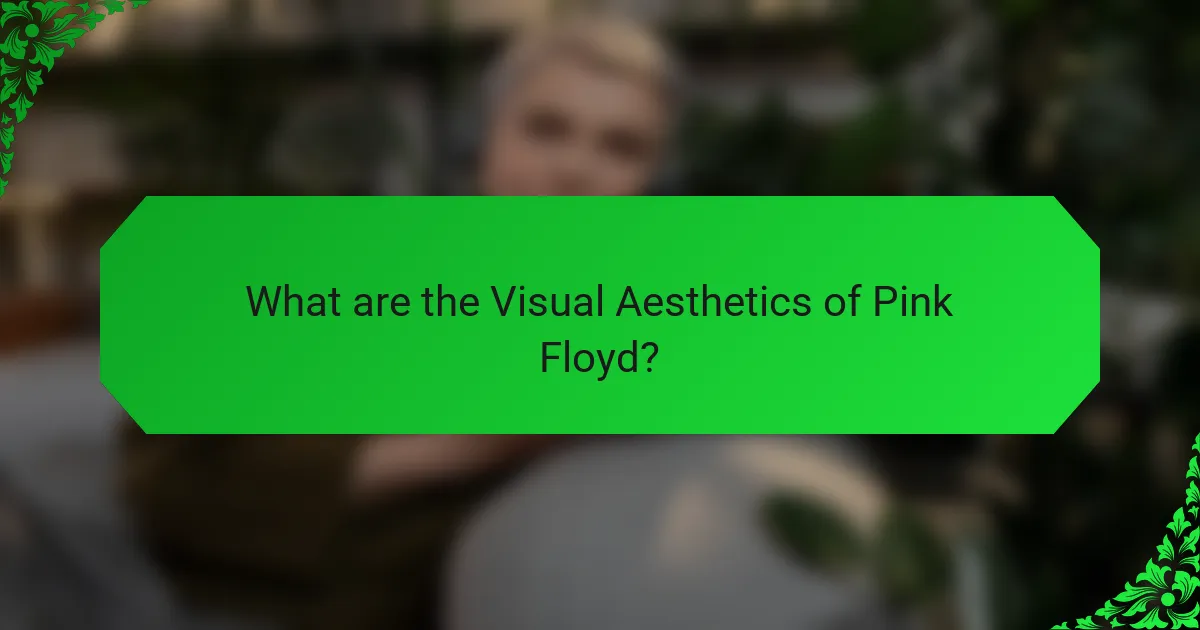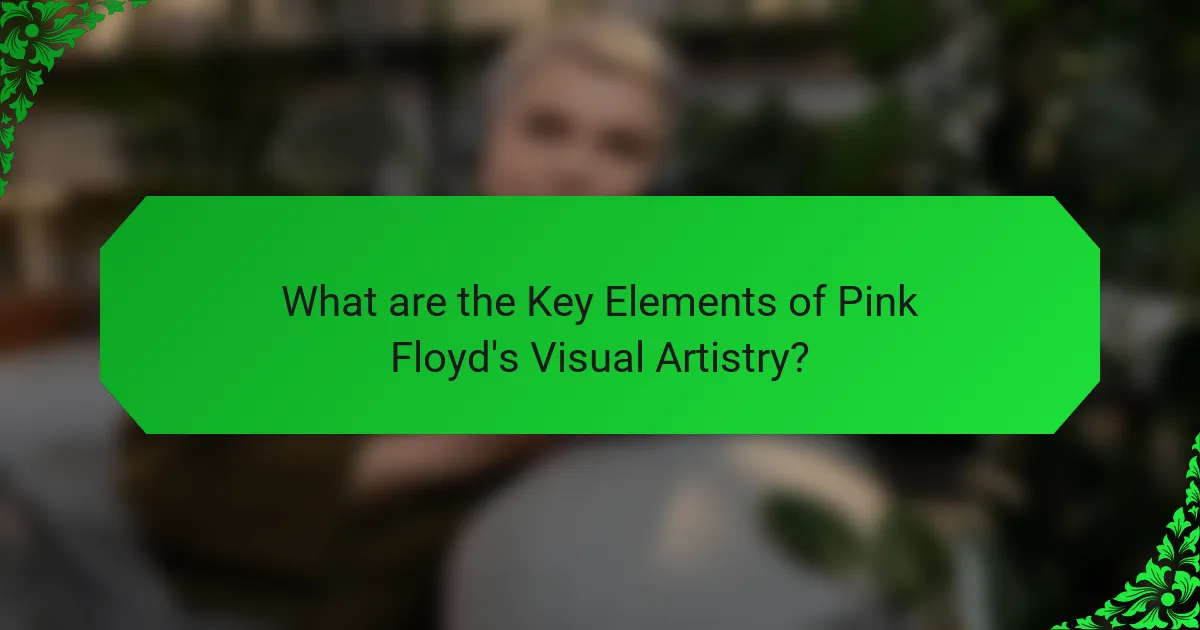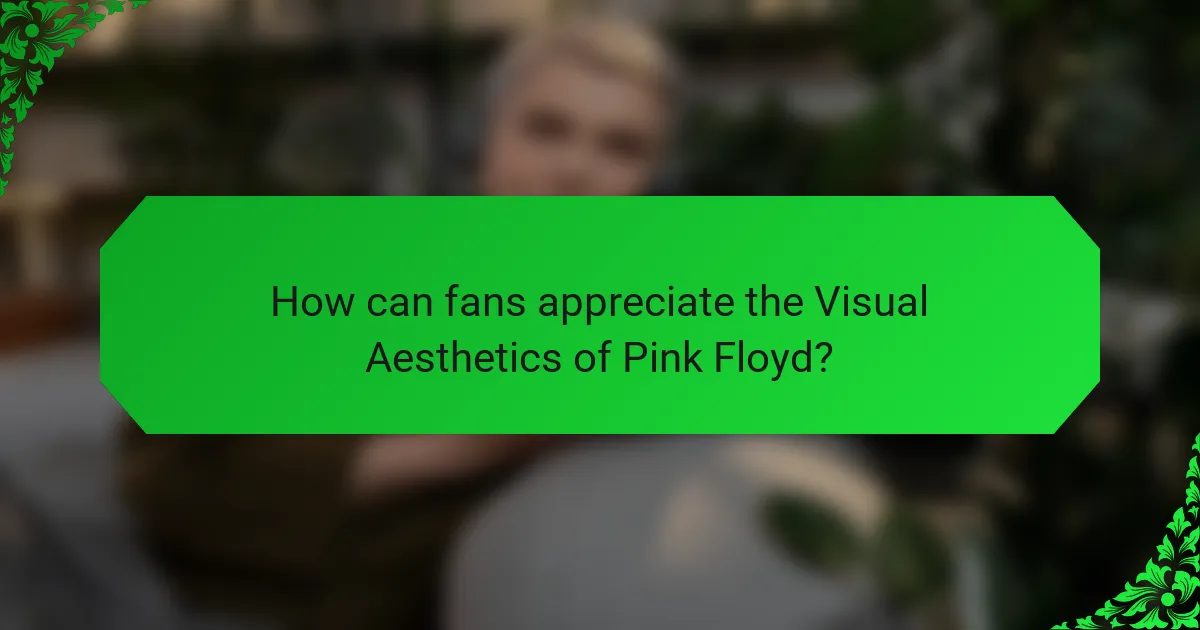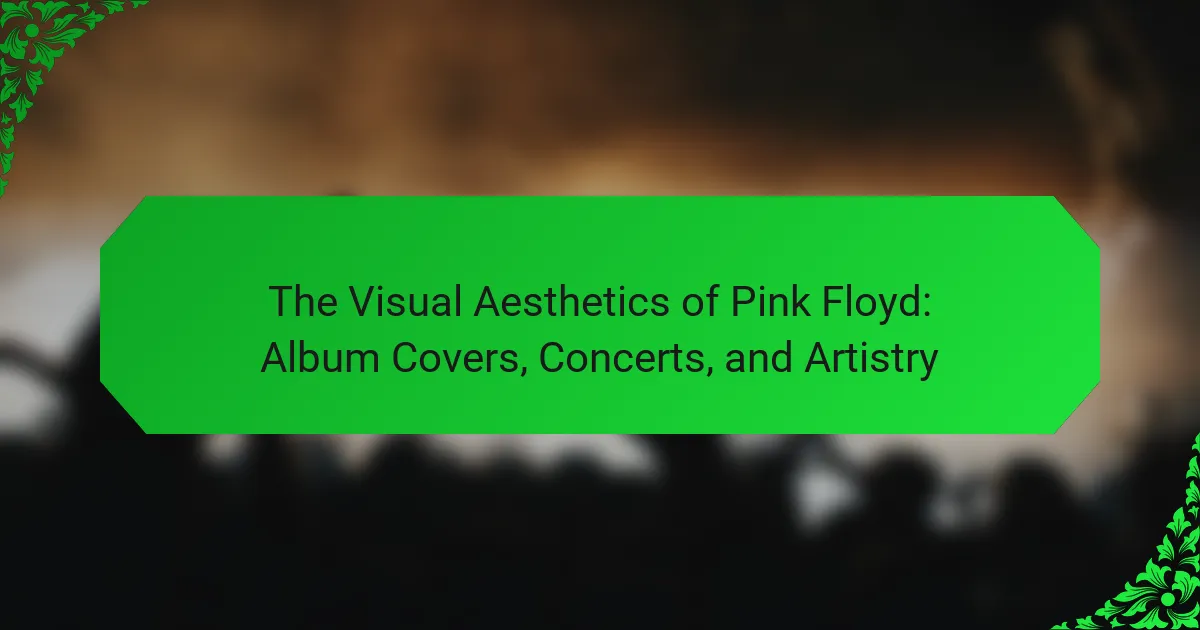The article explores the visual aesthetics of Pink Floyd, focusing on their innovative album covers, concert visuals, and overall artistry. It highlights how their surreal imagery and abstract concepts, exemplified by iconic works like “The Dark Side of the Moon” and “Wish You Were Here,” reflect the themes of their music. The collaboration with graphic designer Storm Thorgerson is emphasized as a key influence on their visual identity, combining photography with surreal elements. Additionally, the article discusses the immersive experience created by elaborate light shows and thematic visuals during live performances, which enhance the emotional connection to their music. Overall, Pink Floyd’s visual elements play a significant role in their artistic expression and impact on music culture.

What are the Visual Aesthetics of Pink Floyd?
The visual aesthetics of Pink Floyd are characterized by surreal imagery, abstract concepts, and innovative design. Their album covers often feature striking visuals that reflect the themes of their music. For example, “The Dark Side of the Moon” features a prism dispersing light, symbolizing the spectrum of human experience. The artwork for “Wish You Were Here” depicts two businessmen shaking hands, one on fire, representing alienation and the music industry. Concert visuals include elaborate light shows and projections, enhancing the immersive experience. The band’s collaboration with graphic designer Storm Thorgerson significantly shaped their visual identity. Thorgerson’s work often combined photography with surreal elements, creating iconic images. Overall, Pink Floyd’s visual aesthetics complement their musical exploration of complex themes.
How do Pink Floyd’s album covers reflect their musical identity?
Pink Floyd’s album covers reflect their musical identity through innovative design and thematic depth. The iconic prism on “The Dark Side of the Moon” symbolizes the band’s exploration of light and sound. It represents the spectrum of human experience, mirroring their lyrical themes of mental health and existentialism. “Wish You Were Here” features a stark image of two businessmen shaking hands, highlighting themes of alienation and the music industry. The surreal landscape of “Animals” critiques societal structures, paralleling the band’s progressive rock sound. Each cover serves as a visual extension of the band’s conceptual narratives. The artwork often engages with philosophical and psychological concepts, reinforcing their identity as pioneers in both music and visual art.
What themes and concepts are depicted in Pink Floyd’s album art?
Pink Floyd’s album art depicts themes of alienation, existentialism, and the human experience. The iconic cover of “The Dark Side of the Moon” symbolizes the complexity of life and mental health. Imagery often includes surreal landscapes and abstract designs, reflecting the band’s psychedelic roots. The use of light and shadow conveys emotional depth and introspection. Symbolism, such as the prism on the “Dark Side” cover, represents enlightenment and perception. “Animals” features industrial imagery, critiquing societal structures and capitalism. The artwork for “The Wall” illustrates themes of isolation and emotional barriers. Overall, Pink Floyd’s album art serves as a visual extension of their music’s philosophical and emotional explorations.
How do the colors and designs used influence the listener’s perception?
Colors and designs significantly influence the listener’s perception by evoking specific emotions and associations. For instance, warm colors like red and orange can create feelings of excitement or urgency. In contrast, cool colors such as blue and green often evoke calmness or tranquility. The design elements, including shapes and patterns, further enhance these emotional responses. For example, sharp angles may convey tension, while soft curves suggest comfort. Research indicates that visual stimuli can affect auditory processing, leading to a more immersive experience. A study by Palmer and Schloss (2010) found that color and sound interactions can shape emotional responses and preferences. Thus, the visual aesthetics of album covers and concert designs play a crucial role in shaping how listeners perceive the music.
What role do concerts play in the visual representation of Pink Floyd?
Concerts play a crucial role in the visual representation of Pink Floyd. They are integral to the band’s identity and artistic expression. The elaborate stage designs and visual effects enhance the music experience. Iconic concerts, like those at the 1977 Animals tour, showcased innovative projections and light shows. These visuals often reflected the themes of their albums. For example, “The Wall” tour featured a massive wall that became a central visual element. The combination of music and visuals created a unique atmosphere. This synergy contributed to Pink Floyd’s reputation as pioneers in concert artistry.
How does stage design enhance the overall concert experience?
Stage design enhances the overall concert experience by creating a visually immersive environment. It integrates lighting, props, and visuals to complement the music. This synergy engages the audience on multiple sensory levels. For example, Pink Floyd’s elaborate stage setups include large-scale projections and intricate light shows. Such designs can evoke emotional responses and deepen the connection to the music. Research indicates that visual elements can significantly impact audience enjoyment and retention of the performance. A well-crafted stage design transforms a concert into a memorable event, making it more than just a musical performance.
What visual elements are consistently present in Pink Floyd’s live performances?
Pink Floyd’s live performances consistently feature elaborate light shows, large-scale projections, and intricate stage designs. The light shows often include colored lasers and smoke effects that enhance the music’s emotional impact. Large-scale projections display surreal imagery and animations that correlate with song themes. The stage designs are often monumental, creating immersive environments for the audience. Additionally, the use of puppetry and visual storytelling elements adds depth to the performance. These visual elements have been integral to Pink Floyd’s identity since the late 1960s, particularly during their iconic tours like “The Wall” and “Animals.” The combination of these elements creates a unique audiovisual experience that has defined their concerts.
How has Pink Floyd’s artistry evolved over time?
Pink Floyd’s artistry has evolved significantly from their early days to their later works. Initially, their music was heavily influenced by psychedelic rock. Their debut album, “The Piper at the Gates of Dawn,” showcased experimental sounds and whimsical lyrics. As they progressed, they began to incorporate more complex themes and concepts. The album “The Dark Side of the Moon” marked a turning point with its cohesive structure and thematic depth. This album became one of the best-selling albums of all time, highlighting their artistic maturity.
In the 1970s, Pink Floyd further developed their sound with “Wish You Were Here” and “Animals.” These albums reflected societal issues and personal experiences. The use of elaborate live shows and visual effects became a hallmark of their performances. Their later work, “The Wall,” introduced a rock opera format, combining narrative storytelling with music. This evolution demonstrated their ability to blend visual artistry with musical innovation.
Throughout their career, Pink Floyd’s visual aesthetics have also transformed. Their album covers, designed by Storm Thorgerson, became iconic representations of their music. The combination of thought-provoking imagery and sound has made their artistry timeless and influential.
What unique visual styles emerged with different albums?
Pink Floyd’s albums showcase distinct visual styles that reflect their musical evolution. “The Piper at the Gates of Dawn” features whimsical, surreal artwork by design group Hipgnosis. “The Dark Side of the Moon” employs a prism design, symbolizing the spectrum of human experience. “Wish You Were Here” presents a stark image of two businessmen shaking hands, highlighting themes of alienation. “Animals” uses a stark industrial image of Battersea Power Station, reflecting societal critique. “The Wall” utilizes a minimalist, stark visual approach to convey isolation and despair. Each album’s artwork aligns with its thematic content, enhancing the listener’s experience. The unique visual styles contribute significantly to Pink Floyd’s identity as a band.
How do collaborations with artists influence their visual aesthetics?
Collaborations with artists significantly influence visual aesthetics by introducing diverse styles and perspectives. These partnerships often blend distinct artistic visions, resulting in unique visual representations. For example, Pink Floyd’s collaboration with graphic designer Storm Thorgerson led to iconic album covers like “The Dark Side of the Moon.” This specific cover features a prism that symbolizes the band’s exploration of light and sound. The interplay of different artistic techniques can enhance thematic depth and emotional resonance. Collaborations also allow for experimentation with new mediums and technologies, further enriching the visual narrative. Ultimately, such partnerships create a dynamic fusion of creativity that shapes the overall aesthetic experience.

What are the Key Elements of Pink Floyd’s Visual Artistry?
The key elements of Pink Floyd’s visual artistry include innovative album covers, striking live performances, and thematic visual narratives. Their album covers often feature surreal and abstract imagery, exemplified by “The Dark Side of the Moon,” which uses a prism to symbolize light and sound. Live concerts incorporate elaborate light shows, projections, and stage designs that enhance the musical experience. Thematic visuals often reflect philosophical and existential themes, aligning closely with their lyrical content. For instance, “The Wall” features a narrative that addresses isolation and societal issues, visually represented through powerful imagery. Pink Floyd’s collaboration with visual artists like Storm Thorgerson has also significantly shaped their aesthetic identity. This combination of visual elements creates a cohesive and immersive experience for audiences, solidifying their impact on music and art.
How do symbolism and imagery contribute to their visual narrative?
Symbolism and imagery are crucial in shaping the visual narrative of Pink Floyd. They convey complex themes and emotions that resonate with the audience. For example, the prism in “The Dark Side of the Moon” symbolizes the spectrum of human experience. This imagery enhances the album’s exploration of mental health and existentialism. Additionally, the use of surreal landscapes in their concert visuals creates an immersive experience. Such visual elements support the band’s music, reinforcing lyrical messages. The integration of these components ensures a cohesive artistic expression. This approach has been pivotal in establishing Pink Floyd’s identity within the music industry.
What specific symbols are recurrent in Pink Floyd’s artwork?
Recurrent symbols in Pink Floyd’s artwork include the prism, the triangle, and the eye. The prism symbolizes light and the spectrum of sound, notably featured on the “The Dark Side of the Moon” album cover. The triangle often represents the band’s unity and is a recurring element in various visual presentations. The eye, particularly the “Eye of Horus,” signifies knowledge and enlightenment, appearing in several contexts throughout their artwork. These symbols contribute to the thematic depth and visual identity of Pink Floyd, reinforcing their concepts of perception and reality.
How do these symbols relate to the themes of their music?
The symbols used by Pink Floyd relate closely to the themes of their music. Their album covers often depict complex imagery that mirrors the existential and psychological themes in their songs. For instance, the prism on “The Dark Side of the Moon” symbolizes the spectrum of human experience, aligning with the album’s exploration of mental health and the passage of time. Additionally, the use of surreal landscapes in “Wish You Were Here” reflects themes of alienation and loss. The iconic imagery of the wall in “The Wall” serves as a metaphor for isolation and emotional barriers. Each symbol enhances the listener’s understanding of the underlying messages in their music. This connection between visual elements and thematic content creates a cohesive artistic experience.
What techniques do Pink Floyd use in their visual presentations?
Pink Floyd employs various techniques in their visual presentations, including innovative lighting, elaborate stage designs, and multimedia projections. They utilize synchronized visuals that enhance the musical experience. Iconic use of lasers and smoke creates a surreal atmosphere during performances. Their album covers often feature surreal artwork, reflecting themes of the music. Collaborations with visual artists, such as Storm Thorgerson, contribute to their distinctive style. The integration of film and animation in concerts adds depth to storytelling. These techniques collectively create an immersive experience for audiences.
How does the use of light and projection affect the audience’s experience?
The use of light and projection significantly enhances the audience’s experience during performances. It creates an immersive environment that captivates viewers. Bright and dynamic lighting can evoke emotions and set the mood of a performance. Projections can visually narrate themes, reinforcing the music’s message. Research shows that visual elements can increase audience engagement by up to 30%. For instance, Pink Floyd’s concerts utilized elaborate light shows and projections to complement their music. This synergy between sound and visuals deepens the overall impact on the audience.
What innovative methods have they employed in their album covers and concerts?
Pink Floyd has employed innovative methods in their album covers and concerts by integrating visual art and technology. Their album covers often feature surreal imagery and complex designs, such as the iconic prism on “The Dark Side of the Moon.” This cover was designed by Hipgnosis and symbolizes the band’s exploration of light and sound.
In concerts, they utilize advanced lighting and projection techniques. For instance, their “The Wall” tour featured a massive wall built on stage that was gradually torn down during the performance. This visual storytelling enhanced the emotional impact of the music.
Additionally, Pink Floyd incorporated multimedia elements, such as film projections and elaborate stage sets. Their use of lasers and pyrotechnics during live shows created an immersive experience for the audience. This combination of art and technology set new standards for live performances in rock music.

How can fans appreciate the Visual Aesthetics of Pink Floyd?
Fans can appreciate the visual aesthetics of Pink Floyd by exploring their iconic album covers, concert visuals, and artistic themes. The band collaborated with renowned artists like Storm Thorgerson, whose designs for albums such as “The Dark Side of the Moon” have become legendary. Fans can analyze the symbolism in these visuals, such as the prism effect representing light and sound. Attending live performances allows fans to experience the immersive visual effects created by elaborate light shows and projections. Pink Floyd’s use of surreal and abstract imagery in their artwork enhances the listener’s emotional connection to the music. Documentaries and books about the band’s visual artistry provide deeper insights into their creative process. Engaging with fan communities and discussions can also enrich understanding of the aesthetic elements present in their work.
What are some tips for analyzing Pink Floyd’s album covers?
To analyze Pink Floyd’s album covers, start by examining the visual themes present in each cover. Note recurring motifs such as light, darkness, and surreal imagery. Consider the historical context of the album’s release. This can provide insight into the artistic choices made. Pay attention to the color palette used in the artwork. Specific colors can evoke particular emotions or concepts. Analyze the symbolism within the imagery. Many covers contain hidden meanings or references to the band’s lyrics. Research the artists behind the designs, such as Storm Thorgerson. Understanding their vision can enhance your interpretation. Lastly, compare the covers to the music itself. This can reveal how the visuals complement the auditory experience.
How can fans identify the deeper meanings within the artwork?
Fans can identify the deeper meanings within the artwork by analyzing visual elements and symbols. Each piece often contains specific imagery that reflects themes in Pink Floyd’s music. For example, the prism in “The Dark Side of the Moon” symbolizes light and the spectrum of human experience. Fans should also consider the context of the album and its lyrics. Understanding the historical and social backdrop can provide insights into the artwork’s significance. Additionally, engaging with interviews and commentary from the band members reveals their intentions and interpretations. Art criticism and analysis from experts can further enhance understanding. By examining these facets, fans can uncover layers of meaning embedded in the artwork.
What resources are available for exploring Pink Floyd’s visual artistry?
Books on Pink Floyd’s visual artistry include “The Pink Floyd Encyclopedia” by Vernon Fitch and “The Visual History of Pink Floyd” by Roger Waters. Documentaries such as “Pink Floyd: The Wall” provide insights into their artistic vision. Online platforms like the official Pink Floyd website offer galleries and archival footage. Social media accounts dedicated to Pink Floyd showcase fan art and historical visuals. Art exhibitions featuring their work have occurred, such as “The Pink Floyd Exhibition: Their Mortal Remains.” These resources collectively highlight the band’s innovative visual contributions.
Where can fans find collections or exhibitions of their artwork?
Fans can find collections or exhibitions of Pink Floyd’s artwork at various museums and galleries. Notable locations include the Victoria and Albert Museum in London, which has hosted exhibitions featuring album art. The British Music Experience in Liverpool also showcases artifacts related to the band’s visual aesthetics. Additionally, traveling exhibitions may appear in different cities, featuring artwork and memorabilia. Online platforms sometimes host virtual exhibitions that display Pink Floyd’s artistic contributions. These venues provide fans with opportunities to engage with the band’s visual legacy.
How can fans recreate the essence of Pink Floyd’s visuals in their own art?
Fans can recreate the essence of Pink Floyd’s visuals in their own art by incorporating surreal imagery and vibrant colors. They should use geometric shapes and light effects, reminiscent of the band’s iconic album covers. Utilizing themes of existentialism and metaphysical concepts will enhance the depth of the artwork. Fans can also experiment with mixed media techniques, blending photography, painting, and digital art.
Incorporating elements like prisms or abstract landscapes can evoke the distinctive style of Pink Floyd. Analyzing works like “The Dark Side of the Moon” cover by Storm Thorgerson provides inspiration. This artwork features a simple yet powerful prism effect that symbolizes complexity. Fans should also consider using projection techniques, similar to those used in Pink Floyd concerts, to create immersive experiences. Overall, these strategies can effectively capture the visual essence of Pink Floyd in personal artistic expressions.
The main entity of the article is Pink Floyd, a renowned rock band known for their innovative visual aesthetics. The article explores the band’s distinctive album covers, concert visuals, and overall artistry, highlighting key themes such as alienation, existentialism, and the human experience. It examines how visual elements like symbolism, color, and design enhance the listener’s perception and emotional connection to their music. Additionally, the article discusses the evolution of Pink Floyd’s visual identity through collaborations with artists and the impact of their elaborate live performances. Overall, it provides a comprehensive overview of how Pink Floyd’s visual artistry complements their musical exploration.
